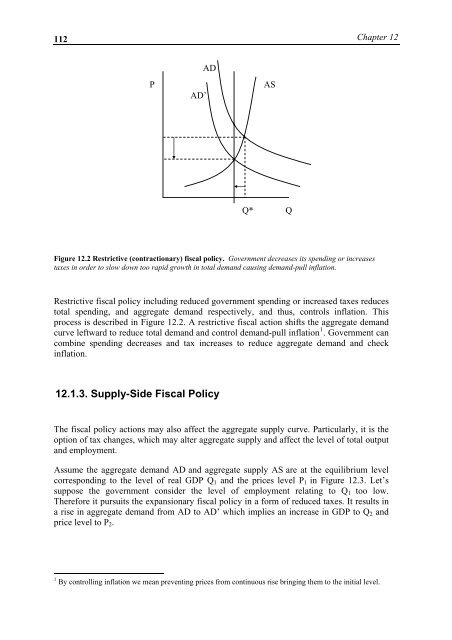MacroeconomicsI_working_version (1)
Create successful ePaper yourself
Turn your PDF publications into a flip-book with our unique Google optimized e-Paper software.
112<br />
Chapter 12<br />
P<br />
AD’<br />
AD<br />
AS<br />
Q*<br />
Q<br />
Figure 12.2 Restrictive (contractionary) fiscal policy. Government decreases its spending or increases<br />
taxes in order to slow down too rapid growth in total demand causing demand-pull inflation.<br />
Restrictive fiscal policy including reduced government spending or increased taxes reduces<br />
total spending, and aggregate demand respectively, and thus, controls inflation. This<br />
process is described in Figure 12.2. A restrictive fiscal action shifts the aggregate demand<br />
curve leftward to reduce total demand and control demand-pull inflation 1 . Government can<br />
combine spending decreases and tax increases to reduce aggregate demand and check<br />
inflation.<br />
12.1.3. Supply-Side Fiscal Policy<br />
The fiscal policy actions may also affect the aggregate supply curve. Particularly, it is the<br />
option of tax changes, which may alter aggregate supply and affect the level of total output<br />
and employment.<br />
Assume the aggregate demand AD and aggregate supply AS are at the equilibrium level<br />
corresponding to the level of real GDP Q 1 and the prices level P 1 in Figure 12.3. Let’s<br />
suppose the government consider the level of employment relating to Q 1 too low.<br />
Therefore it pursuits the expansionary fiscal policy in a form of reduced taxes. It results in<br />
a rise in aggregate demand from AD to AD’ which implies an increase in GDP to Q 2 and<br />
price level to P 2 .<br />
1 By controlling inflation we mean preventing prices from continuous rise bringing them to the initial level.




